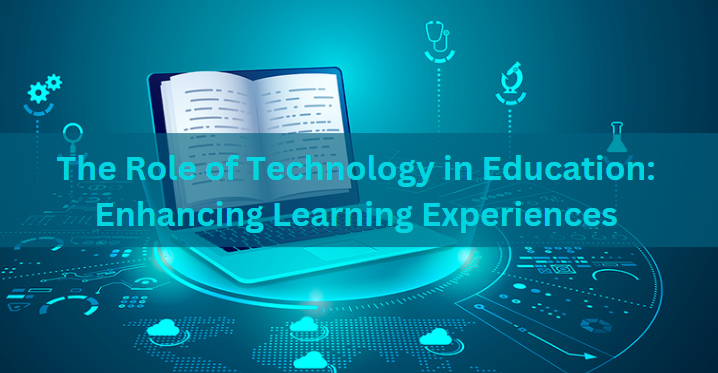The Role of Technology in Education: Enhancing Learning Experiences
In today’s digital age, technology plays a pivotal role in shaping the landscape of education. From interactive learning platforms to virtual classrooms, technology has revolutionized the way we teach and learn. This article explores the various ways technology enhances learning experiences, the benefits it brings, the challenges it poses, and the future directions of technology in education.
Contents [hide]
- 1 1. Interactive Learning Platforms
- 2 2. Virtual and Augmented Reality
- 3 3. Personalized Learning
- 4 4. Collaborative Learning Tools
- 5 5. Digital Resources and E-Libraries
- 6 6. Artificial Intelligence in Education
- 7 Challenges of Technology in Education
- 8 Future Directions of Technology in Education
- 9 Conclusion
1. Interactive Learning Platforms
a. Online Courses and MOOCs
Massive Open Online Courses (MOOCs) and other online learning platforms provide access to high-quality education from renowned institutions and educators worldwide. These platforms offer a wide range of courses, enabling students to learn at their own pace and convenience.
b. Gamification
Gamification incorporates game elements into the learning process to engage and motivate students. Interactive quizzes, badges, and leaderboards make learning more enjoyable and foster a competitive spirit among students.
c. Benefits
- Accessibility: Online platforms make education accessible to a global audience.
- Engagement: Gamification enhances student engagement and retention.
- Flexibility: Students can learn anytime, anywhere, at their own pace.
2. Virtual and Augmented Reality
a. Immersive Learning Experiences
Virtual Reality (VR) and Augmented Reality (AR) create immersive learning experiences that bring abstract concepts to life. Students can explore historical sites, conduct virtual science experiments, and visualize complex mathematical problems in a 3D environment.
b. Virtual Field Trips
VR enables virtual field trips to places that might be otherwise inaccessible due to distance, cost, or safety concerns. Students can explore museums, outer space, and underwater environments without leaving the classroom.
c. Benefits
- Engagement: Immersive experiences capture students’ attention and interest.
- Understanding: VR and AR help students better understand and retain complex concepts.
- Accessibility: Virtual field trips make unique learning experiences accessible to all students.
3. Personalized Learning
a. Adaptive Learning Technologies
Adaptive learning technologies use algorithms to personalize the learning experience for each student. These systems adjust the content and pace based on the student’s performance, ensuring that each learner receives instruction tailored to their needs.
b. Data-Driven Insights
Educational technologies collect and analyze data on student performance, providing educators with insights into each student’s strengths and weaknesses. This information helps teachers tailor their instruction and provide targeted support.
c. Benefits
- Customization: Personalized learning addresses individual student needs and learning styles.
- Efficiency: Adaptive technologies optimize the learning process by focusing on areas that need improvement.
- Support: Data-driven insights enable teachers to provide targeted interventions.
4. Collaborative Learning Tools
a. Online Collaboration Platforms
Tools like Google Classroom, Microsoft Teams, and Zoom facilitate collaboration among students and educators. These platforms enable real-time communication, file sharing, and group projects, fostering a collaborative learning environment.
b. Social Learning
Social learning platforms allow students to interact, share ideas, and collaborate on projects. Discussion forums, social media groups, and peer review systems encourage knowledge sharing and collective problem-solving.
c. Benefits
- Collaboration: Technology fosters teamwork and collaboration among students.
- Communication: Real-time communication tools enhance interaction between students and educators.
- Engagement: Social learning platforms keep students engaged and connected.
5. Digital Resources and E-Libraries
a. E-Books and Digital Content
E-books and digital content provide students with access to a vast array of resources. These materials are often interactive, with embedded videos, quizzes, and hyperlinks that enhance the learning experience.
b. Online Libraries and Databases
Online libraries and databases offer a wealth of information, from academic journals to historical archives. Students can access these resources from anywhere, making research more convenient and comprehensive.
c. Benefits
- Access: Digital resources provide access to a wide range of information.
- Interactivity: Interactive content enhances understanding and retention.
- Convenience: Online libraries make research and learning more convenient.
6. Artificial Intelligence in Education
a. Intelligent Tutoring Systems
AI-powered intelligent tutoring systems provide personalized instruction and feedback to students. These systems adapt to the learner’s needs and offer targeted support to help them master specific skills.
b. Automated Grading and Feedback
AI can automate the grading process, providing immediate feedback to students. This allows educators to focus on more complex tasks and provides students with timely information on their performance.
c. Benefits
- Personalization: AI tailors instruction to individual student needs.
- Efficiency: Automated grading saves time and provides immediate feedback.
- Support: Intelligent tutoring systems offer targeted support to help students succeed.
Challenges of Technology in Education
1. Digital Divide
The digital divide refers to the gap between those who have access to technology and the internet and those who do not. Ensuring equitable access to technology is essential to prevent disparities in educational opportunities.
2. Cybersecurity and Privacy
The use of technology in education raises concerns about cybersecurity and the privacy of student data. Schools and educational institutions must implement robust security measures to protect sensitive information.
3. Screen Time and Health
Prolonged screen time can have adverse effects on students’ physical and mental health. It’s important to balance technology use with offline activities and encourage healthy habits.
4. Teacher Training and Support
Effective integration of technology in education requires adequate training and support for teachers. Professional development programs should equip educators with the skills and knowledge needed to use technology effectively in their teaching.
Future Directions of Technology in Education
1. Blended Learning
Blended learning combines traditional classroom instruction with online learning. This approach offers the best of both worlds, providing flexibility while maintaining the benefits of face-to-face interaction.
2. Artificial Intelligence and Machine Learning
AI and machine learning will continue to play a significant role in personalizing learning experiences and providing data-driven insights. Future advancements may include more sophisticated adaptive learning systems and intelligent tutoring platforms.
3. Blockchain for Education
Blockchain technology can enhance the security and transparency of educational records. It can be used to verify credentials, track student achievements, and ensure the integrity of academic records.
4. Augmented Reality and Virtual Reality
AR and VR technologies will become more advanced and accessible, offering even more immersive and interactive learning experiences. These technologies will be used for everything from virtual field trips to simulated lab experiments.
5. Internet of Things (IoT)
IoT devices can enhance the learning environment by providing real-time data and automation. Smart classrooms equipped with IoT devices can offer personalized learning experiences and improve classroom management.
Conclusion
Technology has the power to transform education by enhancing learning experiences, personalizing instruction, and making education more accessible. While there are challenges to overcome, the future of technology in education is promising. By embracing these innovations and addressing the associated challenges, educators can create dynamic and engaging learning environments that prepare students for the demands of the digital age.






















































Post Comment